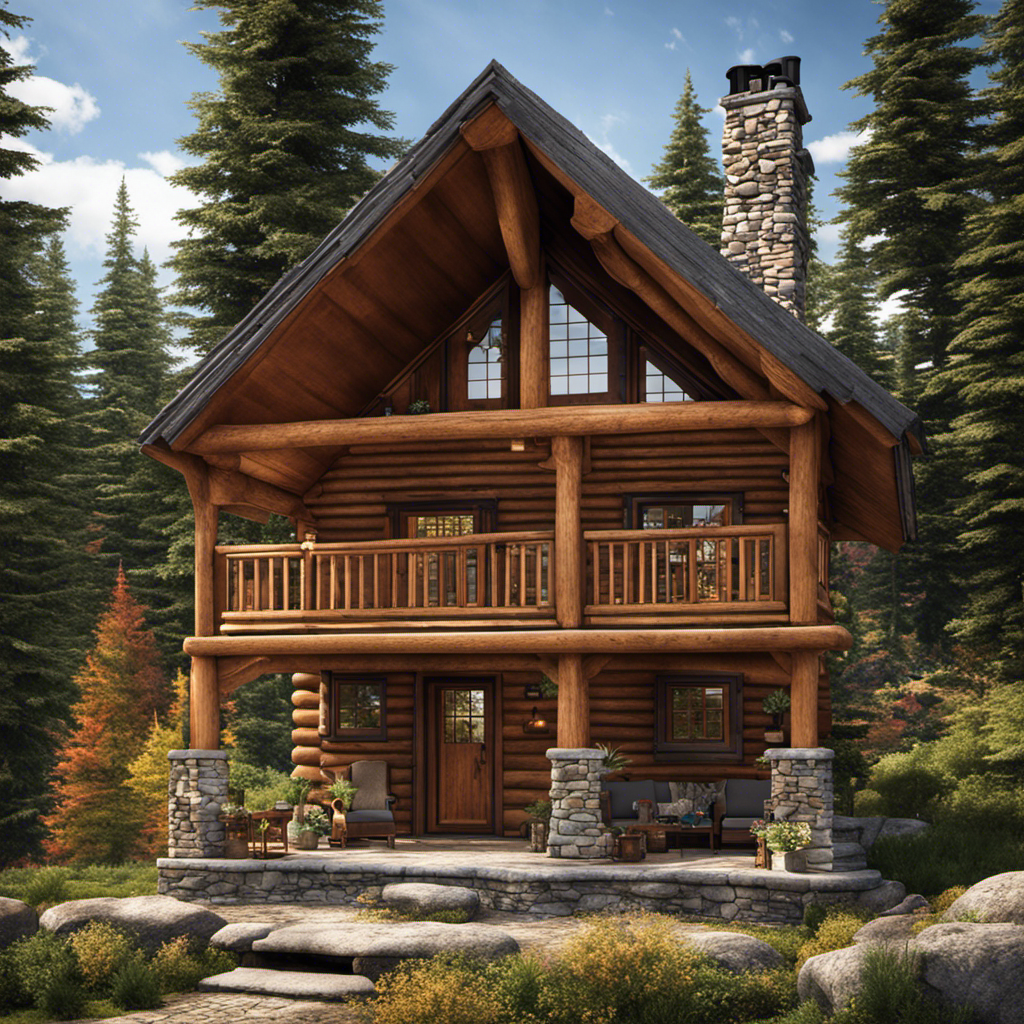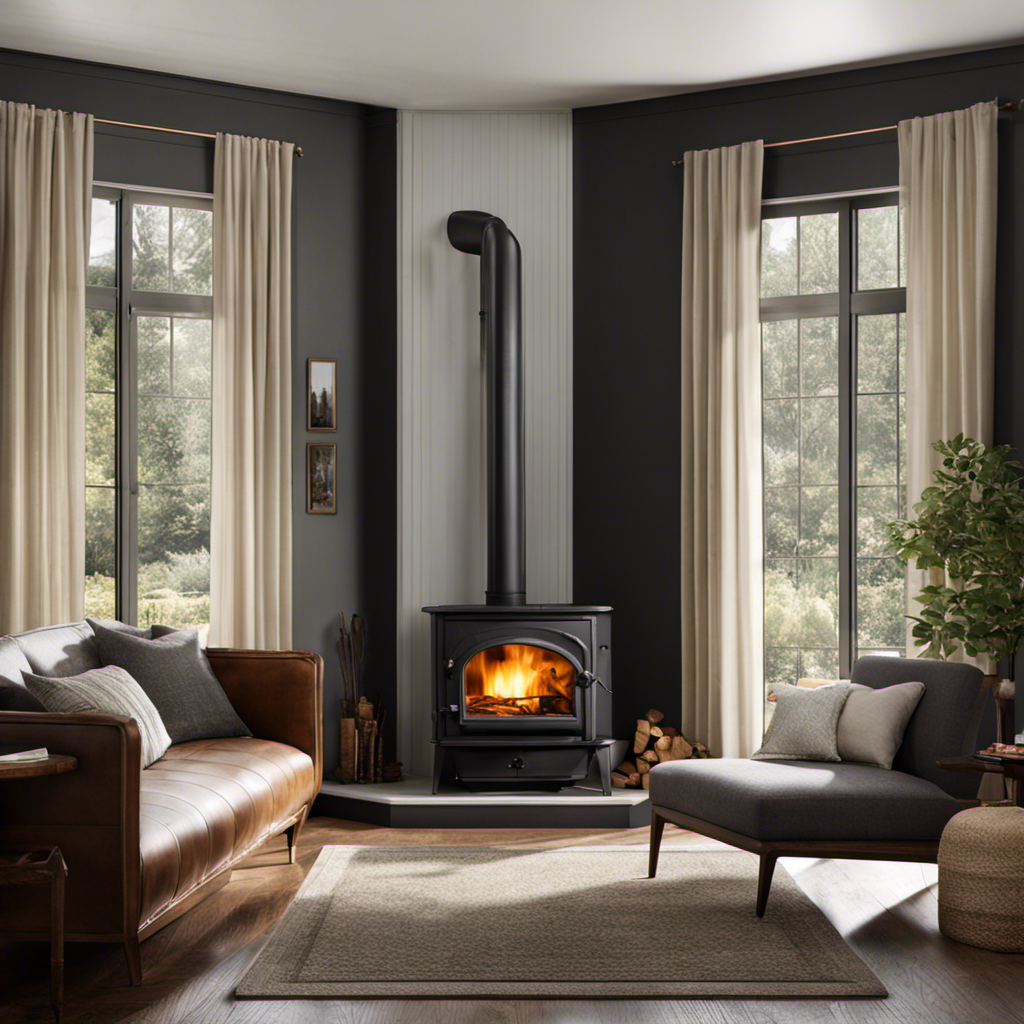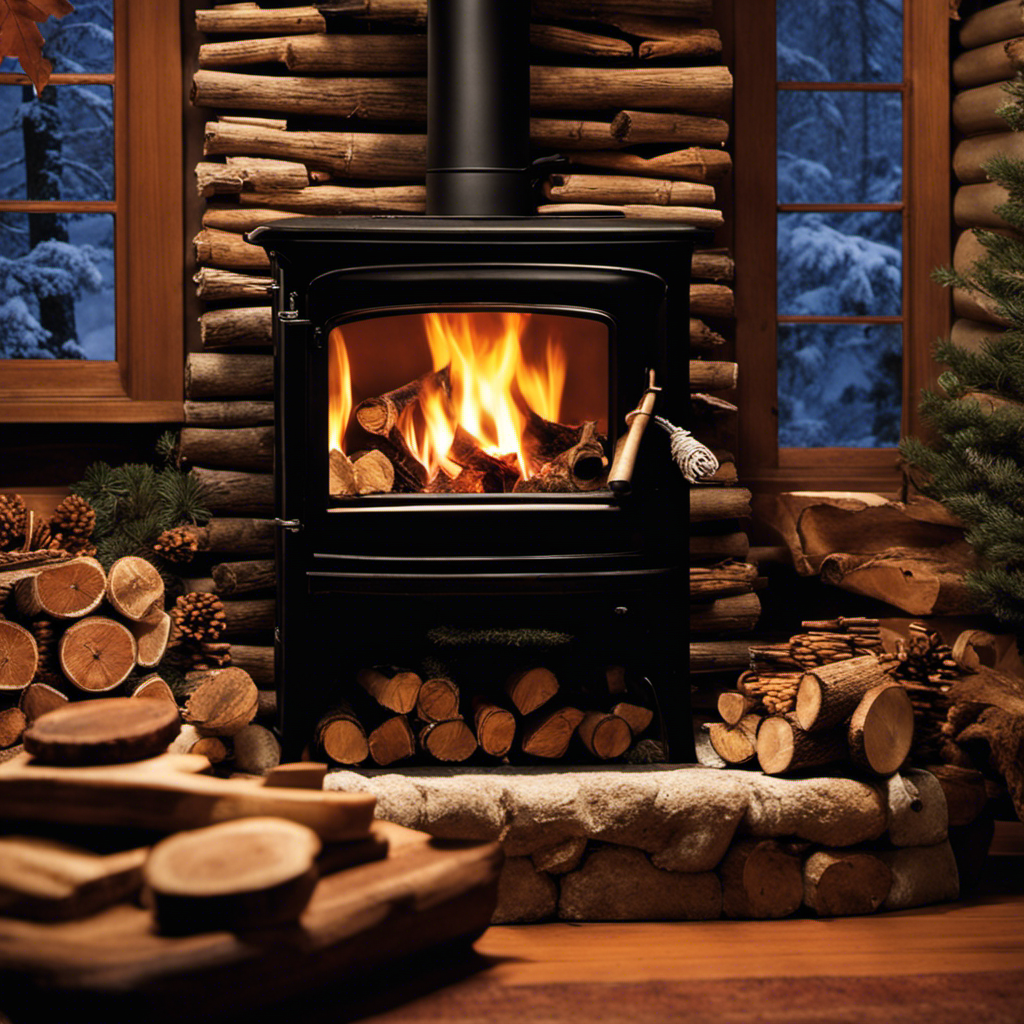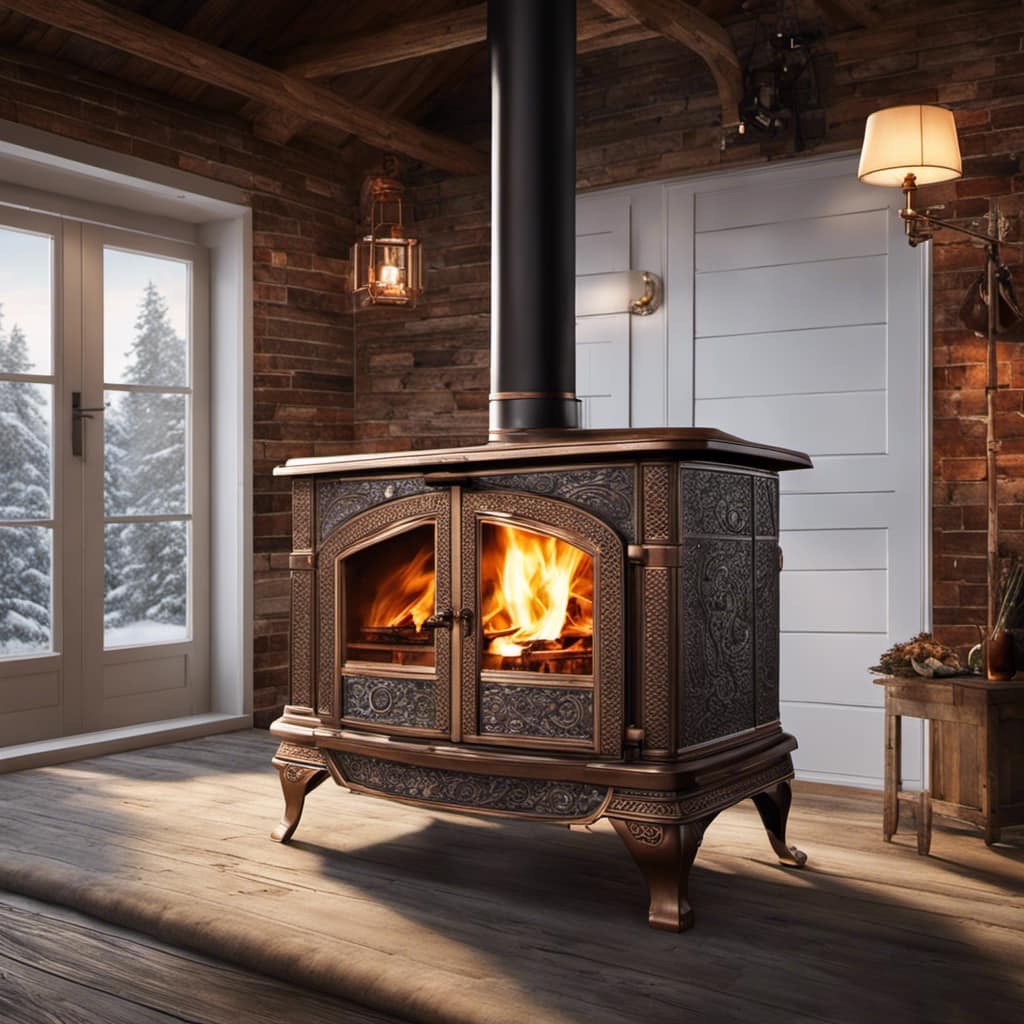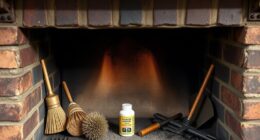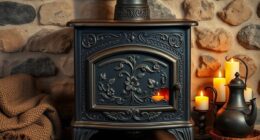Having a considerable amount of experience with wood-burning stoves, I’ve come to understand how crucial the right chimney height is. It functions like the breathing system for your stove, ensuring efficient air circulation and promoting safety.
But how tall should a wood stove chimney be? In this article, I’ll share the guidelines and factors to consider in determining the ideal height.
By avoiding common mistakes and getting it right, you can enjoy a cozy fire while keeping your home safe and warm.
Key Takeaways
- Proper chimney height is important for efficient ventilation and safety in wood stove installations.
- Short chimneys limit smoke and gas venting, leading to incomplete combustion and potential smoke leakage.
- Tall chimneys create a stronger draft, improving combustion and air circulation.
- Following local building codes and considering roof design is essential for determining the appropriate chimney height.
Importance of Chimney Height for Wood Stove Ventilation
In my experience, having the appropriate chimney height for wood stove ventilation is crucial for ensuring proper air flow and preventing smoke from entering the living space.
Short chimneys can have limitations when it comes to effectively venting the smoke and gases produced by a wood stove. The shorter the chimney, the less draft it can create, resulting in incomplete combustion and potential smoke leakage.
On the other hand, tall chimneys have numerous benefits. They create a stronger draft, allowing for efficient combustion and improved air circulation. Tall chimneys also help to reduce the risk of backdrafts, where smoke can be pulled back into the house. Furthermore, tall chimneys can help disperse the smoke higher into the atmosphere, minimizing its impact on the immediate surroundings.
Overall, choosing the right chimney height is essential for optimal wood stove ventilation.
Factors to Consider in Determining Chimney Height for Wood Stoves
When determining the height for a chimney with a wood stove, there are several factors that need to be considered. These factors include:
-
Building Codes:
-
Local building codes may have specific requirements for chimney height to ensure proper ventilation and safety.
-
Compliance with these codes is crucial to avoid potential hazards and ensure the efficiency of the wood stove.
-
Roof Design and Clearance:
-
The pitch and design of the roof play a significant role in determining the chimney height.
-
Sufficient clearance must be maintained to prevent any potential fire hazards and ensure proper draft.
Considering these factors is essential to ensure the safe and efficient operation of a wood stove. By taking into account local building codes and roof design, the appropriate chimney height can be determined.
Now, let’s explore the guidelines for proper chimney height in wood stove installations.
Guidelines for Proper Chimney Height in Wood Stove Installations
I have found that considering local building codes and roof design is crucial in determining the appropriate height for a chimney in wood stove installations.
There are specific guidelines for calculating the proper chimney height in wood stove setups. Several factors influence the chimney height, including the size of the stove, the type of fuel being burned, and the location of the stove in relation to the roofline.
In general, the chimney should extend at least 3 feet above the highest point where it passes through the roof. This ensures that the smoke and gases are fully exhausted and prevents downdrafts.
However, it’s important to consult local building codes and regulations, as they may have specific requirements for chimney height based on factors such as proximity to neighboring structures and prevailing wind patterns.
Common Mistakes to Avoid in Chimney Height for Wood Stove Setups
One mistake I often see isn’t accounting for the height of neighboring structures when determining the appropriate chimney height for a wood stove setup. This can lead to ventilation concerns and potential safety hazards. When planning the height of the chimney, it’s crucial to consider the surrounding structures such as nearby buildings or trees. Here are some common mistakes to avoid:
-
Not assessing the height of neighboring structures:
-
Failing to consider nearby buildings can result in poor chimney draft and inadequate ventilation.
-
Ignoring trees or tall vegetation close to the chimney can lead to blockages and restricted airflow.
-
Neglecting the distance from combustible materials:
-
Placing the chimney too close to combustible materials can raise the risk of fire hazards.
-
Not following the manufacturer’s recommendations for minimum clearance can compromise safety.
Ensuring Safety and Efficiency With the Right Wood Stove Chimney Height
To ensure safety and efficiency, I always consider the height of neighboring structures when determining the appropriate chimney height for my wood stove setup.
The chimney draft plays a crucial role in the proper functioning of a wood stove, as it helps to draw out the combustion gases and maintain a steady burn. Inadequate chimney height can lead to poor draft, resulting in smoke and fumes being trapped inside the house. It’s important to follow the clearance requirements specified by the manufacturer and local building codes to prevent any potential fire hazards.
Additionally, a taller chimney can improve draft by creating a stronger updraft, especially in areas with high wind conditions. By carefully assessing the surrounding structures and adhering to clearance requirements, I can ensure that my wood stove chimney is both safe and efficient.
Frequently Asked Questions
How Do I Know if My Wood Stove Chimney Is the Proper Height?
To accurately measure the height of a wood stove chimney, consider factors such as the stove’s location, roof pitch, and local building codes. Consult a professional for guidance on determining the appropriate chimney height for your specific circumstances.
Can I Install a Wood Stove Chimney With a Height Shorter Than the Recommended Guidelines?
Yes, I can install a wood stove chimney with a shorter height, but it is not recommended. The recommended guidelines ensure proper draft and prevent smoke from entering your home. Using alternative chimney options may be a better solution.
What Are the Consequences of Having a Chimney That Is Too Tall for My Wood Stove?
Having a chimney that is too tall for my wood stove can lead to improper draft and reduced efficiency. This can result in poor combustion, increased fuel consumption, and potential smoke and carbon monoxide buildup in the house.
Are There Any Regulations or Building Codes Regarding the Height of Wood Stove Chimneys?
Regulations and building codes dictate the height of wood stove chimneys to ensure safety. Various factors, including the stove’s location and nearby structures, are considered. Compliance with these standards is crucial for preventing fire hazards and ensuring proper ventilation.
Can I Use an Existing Chimney for My Wood Stove, or Do I Need to Install a New One?
Using an existing chimney for a wood stove has pros and cons. It may save money, but it must meet safety requirements. Installing a new chimney for a wood stove involves cost and considerations such as proper height and construction.
Conclusion
In conclusion, determining the proper height for a wood stove chimney is crucial for ensuring safety and efficiency. By following guidelines and considering factors such as the stove’s BTU output and the height of nearby structures, you can avoid common mistakes and achieve optimal ventilation.
Remember, the right wood stove chimney height guarantees a warm and cozy atmosphere while keeping you and your home safe. So, stay smart and elevate your wood stove experience with the perfect chimney height!
Logan’s affair with adventure began in childhood. He hailed from a small town where vast forests bordered one side and endless shores stretched on the other. His days were spent exploring uncharted woods, climbing tall trees, or listening to the tales of old sailors. This early immersion in a world brimming with stories and mysteries became the foundation of his passion for writing.

